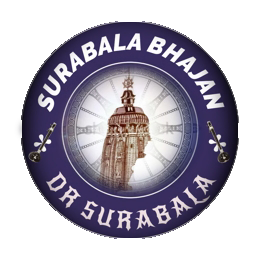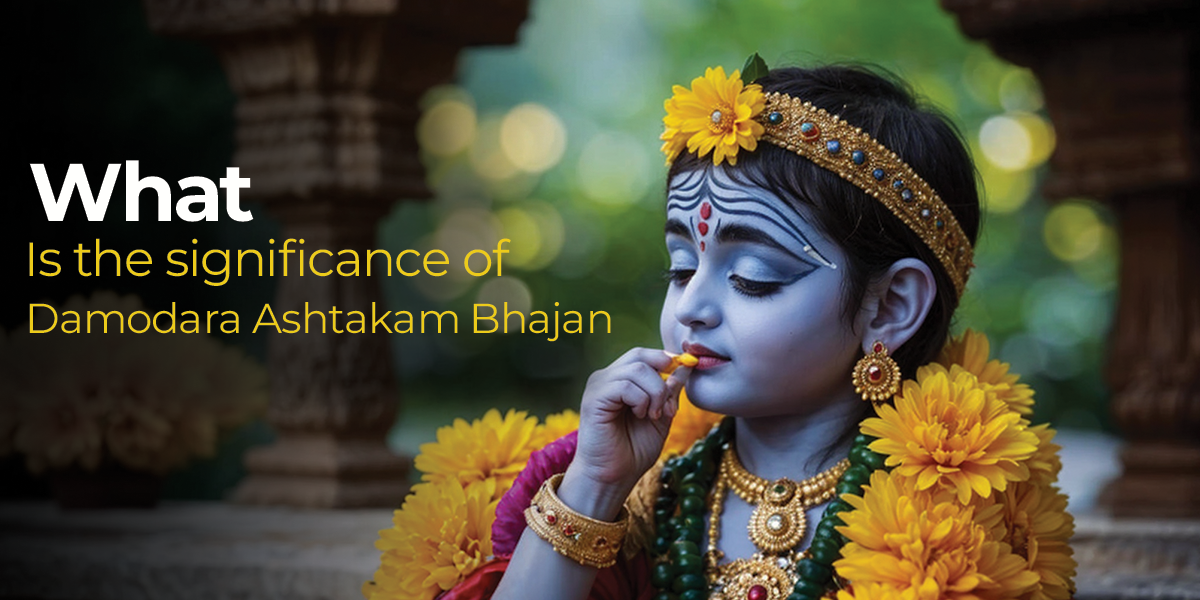A beloved and age-old song with profound spiritual significance in Hinduism, especially among Lord Krishna devotees, is the Damodara Ashtakam Bhajan. One of the most revered months in the Vaishnava calendar is Kartika, which is celebrated from October to November. Moreover, this lovely prayer highlights the great importance of humility, submission, and pure devotion while capturing the love and devotion that Lord Krishna and his followers share.
What is the Damodara Ashtakam Bhajan?
An eight-verse prayer to Lord Damodara, also known as Lord Krishna, is called the Damodara Ashtakam. The term “Damodara” describes how, following a naughty deed, Krishna’s mother Yashoda wrapped him with a rope (Dama) around his abdomen (Udara). Further, the divine love and bond between the mother and the infant in this incident make it one of Krishna’s favorite leelas (divine pastimes) during his early years.
Damodara Ashtakam-
Verse 1:
Namāmīśvaram sac-cid-ānanda-rūpam,
lasat-kuṇḍalam gokule bhrājamanam
yaśodā-bhiyolūkhalād dhāvamānam
parāmṛṣṭam atyantato drutya gopyā.
Translation:
I submit to the everlasting, blissful, and knowledgeable Supreme Lord. He is running quickly in Gokula with his earrings dangling because He is afraid of His mother, Yashoda, who is running after Him to grab Him.
Explanation:
Satyavrata Muni respectfully praises Lord Krishna, symbolizing eternal existence, knowledge, and bliss. Further, the verse emphasizes the beauty of even God’s love for his followers by showing Krishna rushing while wearing swinging earrings out of fear of his mother’s retribution.
Verse 2:
Rudantam muhuh netra-yugmam mṛjantam,
karāmbhoja-yugmena sātaṅka-netram
muhuḥ śvāsa-kampa-trirekhāṅka-kanṭha-
sthita-graivam dāmodaram bhakti-baddham.
Translation:
His eyes are filled with anxiety as He sobs and continuously rubs His tears with His lotus-like hands. As He breathes deeply, the three-line necklace around His neck quivers, showing how Lord Damodara is ensnared by His devotee’s devotion.
Explanation:
His eyes are filled with anxiety as He sobs and continuously rubs His tears with His lotus-like hands. Moreover, as He breathes deeply, the three-line necklace around His neck quivers, showing how Lord Damodara is ensnared by His devotee’s devotion.
Verse 3:
Itīdrk sva-līlābhir ānanda-kuṇḍe
sva-ghoṣaṁ nimajjantam ākhyāpayantam
tadīyeṣita-jñeṣu bhaktair jitattvam
punaḥ prematas tam śatāvṛtti vande.
Translation:
The Lord immerses the inhabitants of Gokula in pleasant waters through these transcendental endeavors. He reveals to those who are engrossed in unadulterated love for Him that devotion, not wisdom or might, is the only way to overcome Him. On several occasions, I pay my respects to the lovely Damodara.
Explanation:
The devotee highlights that love and devotion to Krishna are founded on love and devotion rather than academic pursuit or material strength, and he celebrates Krishna’s spiritual happiness. Further, the poet repeatedly bows to Krishna.
Verse 4:
Varam deva mokṣam na mokṣāvadhim vā
na canyam vṛṇe ‘ham vareṣād apīha
idam te vapur nātha gopāla-bālam
sadā me manasy āvirāstām kim anyaiḥ.
Translation:
I don’t want freedom or any other material blessing, O Lord. All I want is to always perceive you as the cowherd lead you were as a youngster. What’s the point of any other blessing?
Explanation:
The devotee expresses their deep attachment to Krishna’s childhood form, valuing pure devotion over material gain, and expressing their plea to Lord Damodara for liberation.
Verse 5:
Idam te mukhāmbhojam atyanta-nīlair
vṛtam kuntalaiḥ snigdha-raktaiś ca gopyā
muhuś cumbitam bimba-raktādharam me
manasy āvirāstām alam lakṣa-lābhaiḥ.
Translation:
The lips as red as the bimba fruit decorate your face, which is surrounded by beautiful black curls of hair and kissed repeatedly by Mother Yashoda. May I always have this image of Your lovely face in my heart? I don’t require any additional riches.
Explanation:
The devotee admires Krishna’s face, its curly black hair, and the touching scene of Yashoda kissing it, viewing it as more valuable than material gain.
Verse 6:
Namo deva dāmodarānanta viṣṇo
prasīda prabho duḥkha-jālābdhi-magnam
kṛpā-dṛṣṭi-vṛṣṭyāti-dīnam batānū
gṛhāṇeṣa mām ajñam edhy akṣi-dṛśyaḥ.
Translation:
O Lord Damodara! O Vishnu, O Ananta! Please be merciful to me. I am deeply fallen and drowning in a sea of pain. Please pull me up and give me Your kind look.
Explanation:
The verse expresses a plea for divine intervention to lift a soul from material suffering, referencing the supreme position of Krishna, Damodara, Vishnu, and Ananta.
Verse 7:
Kuverātmajau baddha-mūrtyaiva yadvat
tvayā mocitau bhakti-bhājau kṛtau ca
tathā prema-bhaktim svakām me prayaccha
na mokṣa-grho me ‘sti dāmodareha.
Translation:
In the same way that Your kindness delivered Kuvera’s two sons, Manigriva and Nalakuvara, from their curse and transformed them into great devotees, Please give me the gift of devotion. I do not desire liberation.
Explanation:
The devotee prioritizes devotion over monetary rewards and thanks Krishna’s favor for freeing two cursed Kuvera sons from trees.
Verse 8:
Namaste ‘stu dāmne sphurad-dīpti-dhāmne
tvadīyodarayātha viśvasya dhāmne
namo rādhikāyai tvadīya-priyāyai
namo ‘nanta-līlāya devāya tubhyam.
Translation:
I pay my reverent respects to the rope that restrains your abdomen. The entire cosmos resides in Your belly, and I pay my respects to it. I pay my respects to Your most adored, Srimati Radharani, and Your limitless pleasures.
Explanation:
In the concluding line, Krishna’s almighty form is honored, emphasizing His omnipotence and divine bond with His followers. Further, it also honors His celestial pastimes and pays homage to Radharani, his everlasting consort.
Significance of the Name ‘Damodara’:
The name Damodara holds a special meaning. “Dama” means rope, and “Udara” means belly. In the Damodara Leela, the rope around Krishna’s abdomen represents the holy bond between the Lord and his followers. This depiction demonstrates how the unbounded, all-powerful Krishna lets his followers’ unadulterated love rule him. Damodara Ashtakam emphasizes the connection between devotion and submission while celebrating God’s humility and love for his followers.
Historical Background of Damodara Ashtakam:
The Padma Purana, one of the oldest Hindu books, contains the Damodara Ashtakam, which is credited to the great teacher Satyavrata Muni. The hymn glorifies the divine acts of Krishna, focusing on his childhood leelas. Over the centuries, it has become an integral part of Vaishnava devotional practices, especially during the Kartika month.
Conclusion:
The Damodara Ashtakam Bhajan is more than just a hymn; it is a deeply spiritual practice that touches the hearts of Krishna devotees worldwide. It encapsulates the essence of devotion, humility, and love for God, illustrating how the Lord can be bound not by ropes but by the pure love of his devotees. By singing this bhajan, especially during the holy month of Kartika, one can experience spiritual growth, inner peace, and a closer connection with Lord Krishna. Whether through its timeless story, its spiritual significance, or its heartfelt melody, the Damodara Ashtakam continues to inspire and uplift those who seek divine love and guidance.

